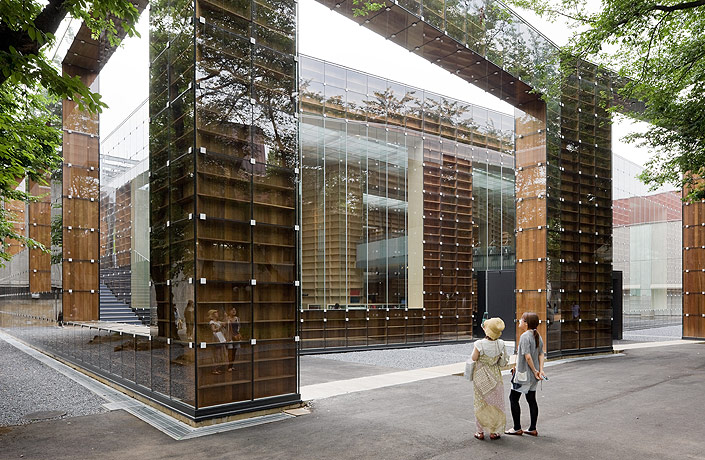武藏野美术大学美术馆·图书馆

下载所需积分: 5
这个项目是为日本一所著名艺术大学设计的新图书馆。它包括设计一座新的图书馆建筑,并将现有建筑改造为艺术画廊,最终实现图书馆与艺术画廊的新融合。
以下描述的项目是新图书馆的计划,位于整体开发的第一阶段。
作为一个巨大的方舟,这座占地 6,500 平方米的双层图书馆容纳了总共 200,000 本书,其中 100,000 本将置于开放档案区,另一半则在封闭档案区。
由书架构成的图书馆
当我思考构成终极图书馆的元素时,它们变成了书籍、书架、光线和空间。我想象了一个被单一书架围绕的螺旋形空间。被无限螺旋包围的领域就是图书馆。
通过 9 米高的墙壁层叠而成的书籍无限森林,墙壁上开有大开口。这种书架的螺旋序列最终包裹了场地的周边,作为外墙,使建筑的外观与书架作为图书馆的基本构成元素相同。
在大学校园中与这条巨大的长书架相遇,瞬间就能识别出这是一个图书馆,同时又令人惊讶于其梦幻般的简约。
最像图书馆的图书馆。
最简单的图书馆。
调查与探索
调查与探索是图书馆设计中固有的两个明显矛盾。调查的定义是为了寻找特定书籍而进行的系统空间安排。即使在谷歌时代,图书馆中寻找书籍的体验也以书籍的物理体积的秩序和排列为特征。与调查相对的概念是探索。图书馆体验的意义也在于空间为用户带来的发现。人们在空间中遇到的是不断更新和转变的体验,发现未定义的关系,并从陌生的领域中获得灵感。
为了实现这两个概念的共存,采用了超越单纯系统化的空间和配置逻辑。
在这里,图书馆固有的两个明显矛盾通过螺旋的形式得以共存,螺旋具有径向路径和旋转运动的两个对立运动。旋转的极性配置实现了调查,而通过径向开口形成的众多层次则通过无限的书籍深度引发了探索的概念。
人们可以隐约识别出整个图书馆,同时想象着有未知的空间不断变得不可察觉。
This project is a new library for one of the distinguished art universities in Japan. It involves designing a new library building and refurbishing the existing building into an art gallery, which will ultimately create a new integration of the Library and the Art Gallery.
The project described hereinafter is the plan of the new library which sits within the first phase of the total development.
Acting as a huge ark, a total of 200,000 units, of which 100,000 will be out in an open-archive, while the other half within closed-archive, rests within this double-storey library of 6,500㎡ in floor area.
Library made from bookshelves
When I thought of the elements which compose an ultimate library, they became books, bookshelves, light and the place. I imagined a place encircled by a single bookshelf in the form of a spiral. The domain encased within the infinite spiral itself is the library.
Infinite forest of books is created from layering of 9m high walls punctuated by large apertures. This spiral sequence of the bookshelf continues to eventually wrap the periphery of the site as the external wall, allowing the external appearance of the building to share the same elemental composition of the bookshelf-as-the-library.
One’s encounter with the colossally long bookshelf within the university landscape registers instantaneously as a library, yet astonishing in its dreamlike simplicity.
The library most library-like.
The simplest library.
Investigation and Exploration
Investigation and exploration are two apparent contradictions inherent in the design of libraries. Investigation is, by definition, a systematic spatial arrangement for the purpose of finding specific books. Even in the age of Google, the experience of searching for books within the library is marked by the order and arrangement of the physical volume of books. The opposing concept to Investigation is the notion of Exploration. The significance of library experience is also in discoveries the space engender to the users. One encounters the space as constantly renewed and transforming, discovers undefined relationships, and gains inspiration from unfamiliar fields.
To achieve the coexistence of the two concepts, spatial and configuration logics beyond mere systematics is employed.
Here, the two apparent contradictions inherent in libraries are allowed to coexist by the form of spiral possessing two antinomic movements of radial path and rotational movement. The rotational; polar configuration achieves investigation, and the numerous layers through the radial apertures engender the notion of Exploration through an infinite depth of books.
One can faintly recognize the entirety of library and at the same time imagine that there are unknown spaces which are rendered constantly imperceptible.
CREDITS
Consultants: Eishi Katsura, adviser;
Jun Sato Structural Engineers--Jun Sato, Masayuki Takada, structural;
Kankyo Engineering--Takafumi Wada, Kazunari Ohishima, Hiroshi Takayama, MEP;
Taku Satoh Design Office--Taku Satoh, Shingo Noma, Kuniaki Demura, Inoue
Industries--Takafumi Inoue, Azusa Jin, Yosuke Goto, Hideki Yamazaki,
furniture & sign;
Sirius Lighting Office--Hirohito Totsune, Koichi Tanaka, lighting;
CAMSA--Katsuyuki Haruki, facade;
STANDARD--Keisou Inami, skylight